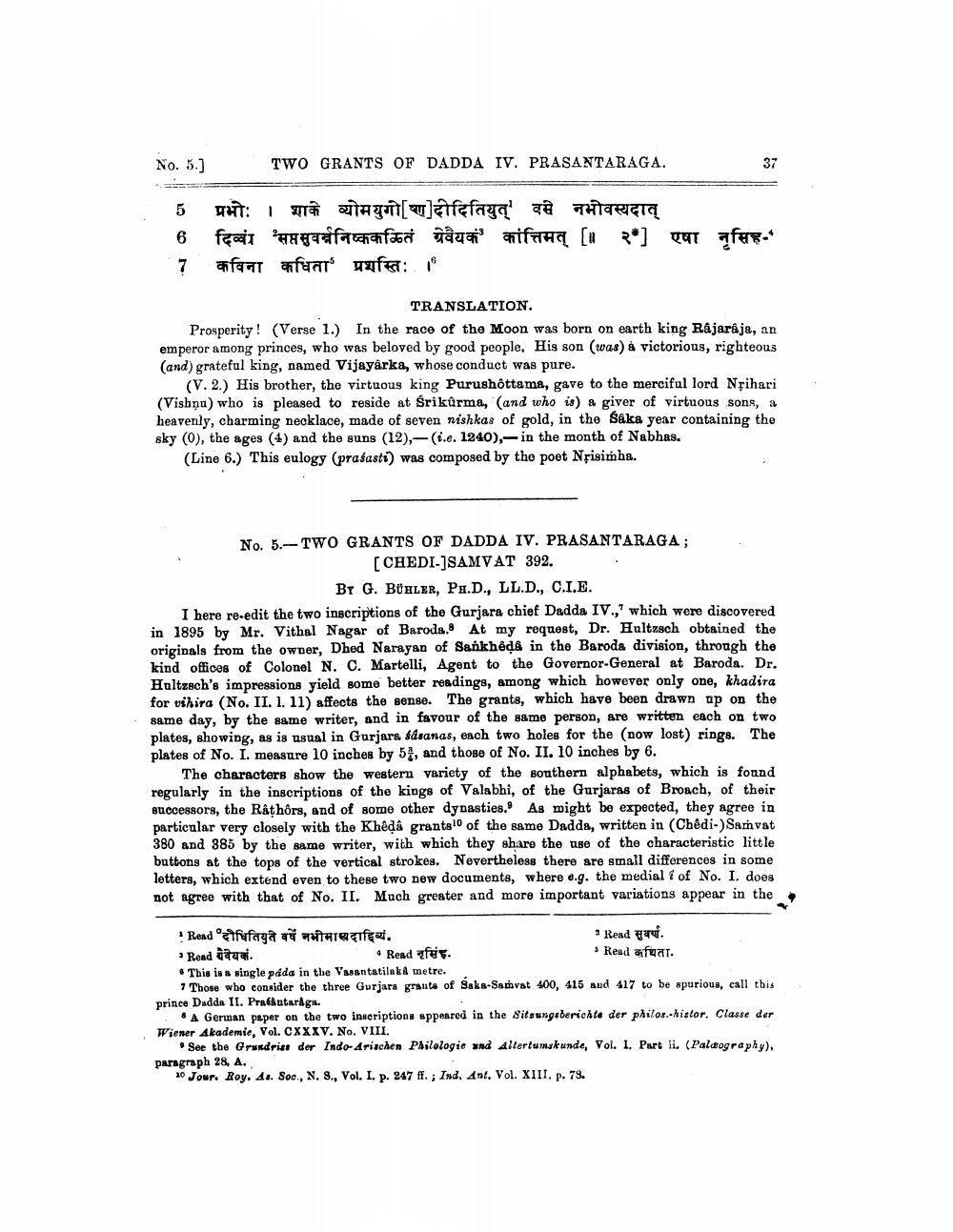________________
No. 5.]
TWO GRANTS OF DADDA IV. PRASANTARAGA.
37
5 : 1 6 fait 7 #qr a
Ag a fefayq' ê tereta grafanc aux arrha [ R] To t aff: 19
afur.
TRANSLATION. Prosperity! (Verse 1.) In the race of the Moon was born on earth king Rajaraja, an emperor among princes, who was beloved by good people. His son (was) á victorious, righteous (and) grateful king, named Vijayarka, whose conduct was pure.
(V. 2.) His brother, the virtuous king Purushottama, gave to the merciful lord Nộihari (Vishnu) who is pleased to reside at srikûrma, (and who is) a giver of virtuous sons, a heavenly, charming necklace, made of seven nishkas of gold, in the sake year containing the sky (0), the ages (4) and the suns (12),-(i.e. 1240),- in the month of Nabhas.
(Line 6.) This eulogy (prasasti) was composed by the poet Nộisimha.
No. 5.-TWO GRANTS OF DADDA IV. PRASANTARAGA :
[CHEDI.]SAMVAT 392.
BY G. BÜHLER, PA.D., LL.D., C.I.E. I here re-edit the two inscriptions of the Gurjara chief Dadda IV.,' which were discovered in 1895 by Mr. Vithal Nagar of Baroda. At my request, Dr. Hultzsch obtained the originals from the owner, Dhed Narayan of Sankhede in the Baroda division, through the kind offices of Colonel N. C. Martelli, Agent to the Governor-General at Baroda. Dr. Holtzsch's impressions yield some better readings, among which however only one, khadira for vihira (No. II. 1. 11) affects the sense. The grants, which have been drawn ap on the same day, by the same writer, and in favour of the same person, are written each on two plates, showing, as is usual in Gurjara Sdsanas, each two holes for the (now lost) rings. The plates of No. I. measure 10 inches by 5%, and those of No. II. 10 inches by 6.
The characters show the western variety of the southern alphabets, which is found regularly in the inscriptions of the kings of Valabhi, of the Gurjaras of Broach, of their successors, the Rathôrs, and of some other dynasties. As might be expected, they agree in particular very closely with the Kheda grants of the same Dadda, written in (Chêdi-) Samvat 380 and 885 by the same writer, with which they share the use of the characteristic little buttons at the tops of the vertical strokes. Nevertheless there are small differences in some letters, which extend even to these two new documents, where e.g. the medial of No. I. does not agree with that of No. II. Much greater and more important variations appear in the
Read °fafaga i recifei.
Read a. Read daug. • Read afer.
* Read fuar. . This is a single pada in the Vasantatilaka metre.
7 Those who consider the three Gurjara grants of Saks-Samvat 400, 415 aud 427 to be spurious, call this prince Dadda II. Pratautardga.
• A German peper on the two inscriptions appeared in the Sitoungsberichte der philos..histor. Classe der Wiener Akademie, Vol. CXXXV. No. VIII.
See the Grundrier der Indo-Arischen Philologie und Altertumskunde, Vol. I. Part ii. (Palæograpày), paragraph 28, A.
10 Jour Roy. 45. Soc., N. S., Vol. I. p. 247 ff.; Ind. Ant. Vol. XIII. p. 73.




